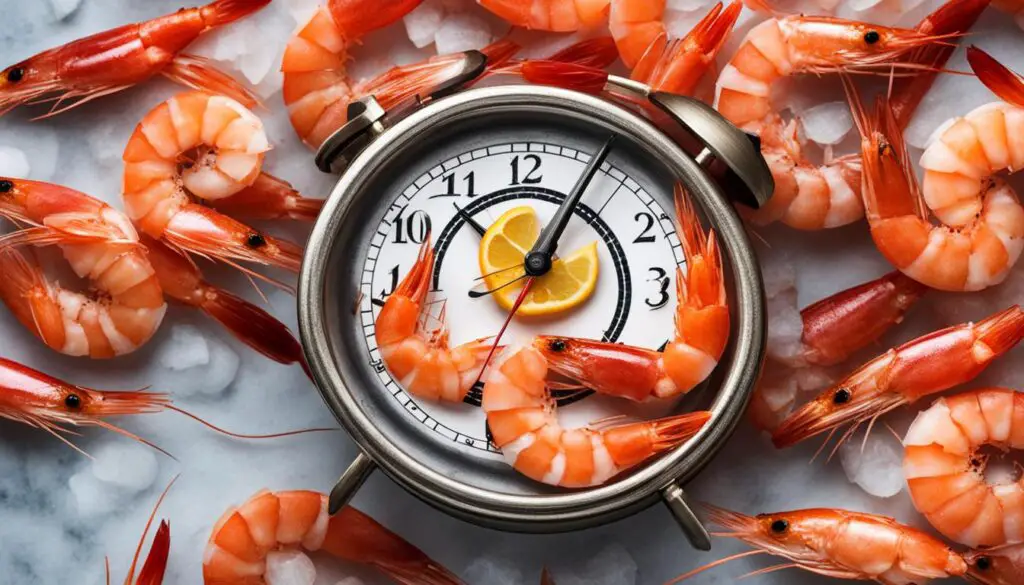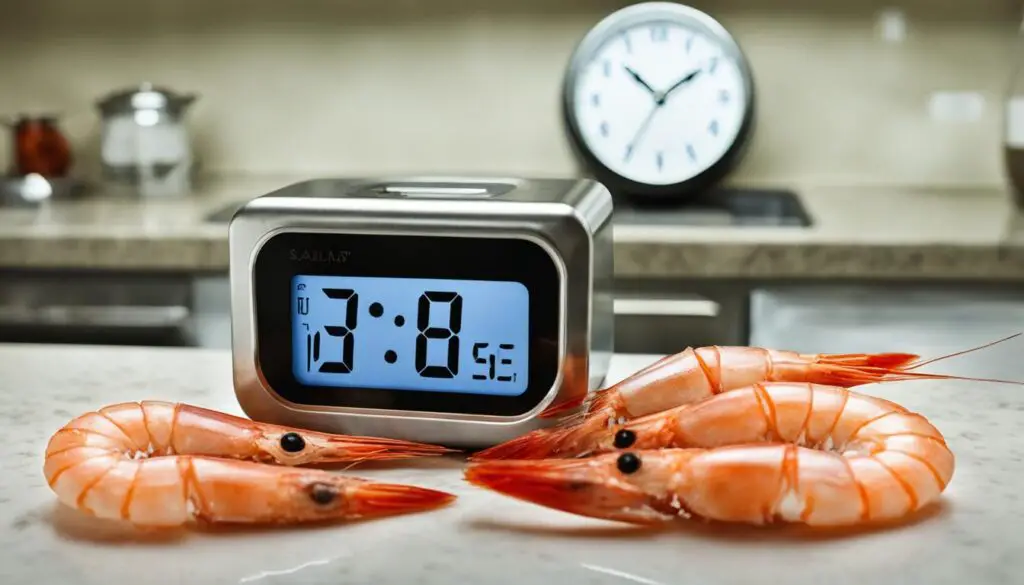Proper storage of shrimp is essential for ensuring food safety and maintaining its freshness. As seafood lovers, we want to enjoy the delicious taste of shrimp without compromising our health. That’s where understanding the safe time for shrimp to be out of the fridge becomes crucial.
According to shrimp storage guidelines, it’s important to refrigerate or freeze shrimp immediately after purchase. Leaving shrimp at room temperature for too long can increase the risk of bacterial growth, leading to potential foodborne illnesses.
The “two-hour rule” applies to perishable foods like shrimp. It’s recommended that shrimp should not be left out at room temperature for more than two hours (or one hour if the air temperature is above 90°F). These guidelines prioritize the safety and quality of the shrimp we consume.
Key Takeaways:
- Storing shrimp in the fridge or freezer immediately after purchase is essential for food safety.
- Adhere to the “two-hour rule” to minimize bacterial growth – don’t leave shrimp out at room temperature for more than two hours.
- Refrigerator temperature should be at or below 40°F, while freezer temperature should be at 0°F.
- Proper storage helps minimize the risk of foodborne illnesses associated with shrimp.
- By following these guidelines, you can ensure the safe storage of shrimp and enjoy its delicious taste without compromising your health.
Refrigeration Tips for Shrimp
To maximize the shelf life of shrimp and maintain its quality, it is important to follow proper refrigeration practices. Here are some best practices for storing shrimp:
-
Keep shrimp in the refrigerator: Store your shrimp in the refrigerator at a temperature below 40°F (4°C). This helps to slow down bacterial growth and maintain freshness.
-
Marinate raw shrimp in the refrigerator: If you’re marinating raw shrimp, it’s advisable to do so in the refrigerator. This prevents the growth of harmful bacteria and ensures food safety.
-
Clean your refrigerator regularly: Regularly clean your refrigerator and wipe spills immediately to prevent cross-contamination. This helps to maintain a clean and safe storage environment for your shrimp.
-
Use covered containers or sealed storage bags: Store shrimp in covered containers or sealed storage bags to prevent odor transfer and minimize moisture loss. This helps to preserve the quality and flavor of the shrimp.
-
Check expiration dates: Always check the expiration dates on shrimp packages and discard any that are past their recommended use-by date. Consuming expired shrimp can pose health risks.
Following these refrigeration tips will help ensure that your shrimp stays fresh and safe to consume.
| Refrigeration Tips for Storing Shrimp |
|---|
| Store shrimp in the refrigerator at a temperature below 40°F (4°C). |
| If marinating raw shrimp, do so in the refrigerator. |
| Clean your refrigerator regularly and wipe spills immediately. |
| Use covered containers or sealed storage bags to prevent odor transfer and moisture loss. |
| Check expiration dates on shrimp packages and discard expired shrimp. |
With these proper refrigeration practices, you can prolong the shelf life of your shrimp and keep it fresh and safe for consumption.
Freezing Guidelines for Shrimp
Freezing is another option for preserving shrimp. When freezing shrimp, it is important to package them properly to maintain their quality. Make sure the packaging is airtight and freezer-safe to prevent freezer burn.
Shrimp can be safely stored in the freezer at 0°F for an extended period. While freezing does not kill bacteria, it slows down their growth, ensuring the safety of the shrimp.
To thaw frozen shrimp, it is recommended to do so gradually in the refrigerator overnight. However, if you need to thaw shrimp quickly, you can use the cold water method or use the defrost setting on your microwave.
By following these freezing guidelines, you can extend the shelf life of shrimp and have a convenient option for long-term storage.

| Freezing Guidelines for Shrimp | |
|---|---|
| 1 | Package shrimp in airtight and freezer-safe containers or bags |
| 2 | Label the packaging with the date of freezing |
| 3 | Ensure the freezer temperature is set at 0°F |
| 4 | Thaw frozen shrimp gradually in the refrigerator overnight |
| 5 | If needed, use the cold water method or microwave defrost setting for quick thawing |
| 6 | Do not refreeze thawed shrimp, consume it within 2 days |
Proper Handling and Serving of Shrimp
Proper handling and serving of shrimp are essential for ensuring food safety and preventing the risk of foodborne illnesses. By following these shrimp handling tips, you can enjoy shrimp dishes confidently and protect the health of yourself and your loved ones.
1. Wash your hands thoroughly
Before and after handling raw shrimp, make sure to wash your hands thoroughly with soap and warm water. This simple step helps remove harmful bacteria and reduces the risk of cross-contamination.
2. Use separate utensils and cutting boards
To prevent cross-contamination, always use separate cutting boards, utensils, and dishware for raw and cooked shrimp. This practice ensures that bacteria from raw shrimp do not come into contact with already cooked shrimp, reducing the chances of foodborne illnesses.
3. Cook shrimp to the right temperature
It’s important to cook shrimp to an internal temperature of 145°F to ensure that any harmful bacteria are destroyed. Use a food thermometer to accurately measure the temperature and ensure thorough cooking.
4. Avoid leaving cooked shrimp out at room temperature
After cooking shrimp, never leave it out at room temperature for more than two hours (or one hour if the temperature is above 90°F). Bacteria can multiply quickly in the “danger zone,” which is between 40°F and 140°F. To prevent bacterial growth, refrigerate cooked shrimp promptly.

Conclusion
Proper storage and handling of shrimp are essential for maintaining its quality and ensuring food safety. By following the recommended shrimp storage guidelines and practicing safe shrimp storage techniques, you can minimize the risk of foodborne illnesses and enjoy shrimp without any worry. Whether you choose to refrigerate or freeze shrimp, it is important to adhere to the proper guidelines to preserve its freshness and flavor.
By refrigerating or freezing shrimp promptly, you can keep it at safe temperatures and slow down bacterial growth. Remember to maintain a refrigerator temperature of 40°F or below and a freezer temperature of 0°F. It is also crucial to practice good hygiene and sanitation when handling shrimp. Wash your hands thoroughly before and after handling raw shrimp, use separate cutting boards and utensils for raw and cooked shrimp, and cook shrimp to the recommended internal temperature of 145°F.
With these shrimp storage guidelines and safe shrimp storage practices in mind, you can confidently enjoy this delicious seafood knowing that you are taking the necessary steps to keep it safe and flavorful. By prioritizing proper storage and handling, you can savor the taste of shrimp while ensuring food safety for yourself and your loved ones. So go ahead and indulge in shrimp dishes while keeping the guidelines in check!
FAQ
How long can cooked shrimp be left out of the fridge?
Cooked shrimp should not be left out at room temperature for more than two hours (or one hour if the air temperature is above 90°F) to prevent bacterial growth and ensure food safety.
Can I marinate raw shrimp at room temperature?
No, it is advisable to marinate raw shrimp in the refrigerator to prevent bacterial growth. This helps to maintain the quality and safety of the shrimp.
How should I store shrimp in the refrigerator?
Store shrimp in covered containers or sealed storage bags to prevent odor transfer and moisture loss. Keep shrimp in the refrigerator at a temperature below 40°F to maximize freshness and quality.
How long can I store shrimp in the freezer?
Shrimp can be safely stored in the freezer at 0°F for an extended period. Freezing slows down bacterial growth and helps preserve the quality of the shrimp. Make sure to use airtight and freezer-safe packaging to prevent freezer burn.
How should I thaw frozen shrimp?
It is recommended to thaw frozen shrimp gradually in the refrigerator overnight. If you need to thaw shrimp quickly, you can use the cold water method or the defrost setting on your microwave. Ensure the shrimp reaches a safe internal temperature before cooking.
What temperature should I cook shrimp to?
Cook shrimp to an internal temperature of 145°F to ensure that harmful bacteria are destroyed. Use a food thermometer to accurately measure the temperature.
Can I reuse cutting boards and utensils after handling raw shrimp?
To prevent cross-contamination, use separate cutting boards, utensils, and dishware for raw and cooked shrimp. Wash these items thoroughly with hot, soapy water or run them through the dishwasher after use.
How long can I leave cooked shrimp out during a party or gathering?
It is important to not leave cooked shrimp out at room temperature for more than two hours (or one hour if the air temperature is above 90°F) to prevent bacterial growth. Consider using chafing dishes or keeping the shrimp on ice to maintain a safe serving temperature.
How can I ensure that my shrimp stays fresh and safe to consume?
By following proper storage and handling guidelines, such as refrigerating or freezing shrimp promptly, maintaining the recommended temperatures, and practicing good hygiene, you can minimize the risk of foodborne illnesses and ensure the freshness and safety of your shrimp.

